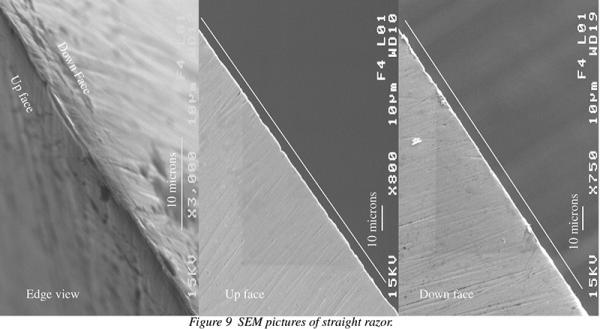View Poll Results: Fins: Fact or Fiction? (public results poll)
- Voters
- 43. You may not vote on this poll
Results 1 to 10 of 104
Thread: Fin: fact or fiction?
Threaded View
-
12-30-2008, 11:21 PM #25Coticule researcher

- Join Date
- Jan 2008
- Location
- Belgium
- Posts
- 1,872
Thanked: 1212
I didn't vote. The existence of the undefined term "fin" cannot be trued or falsified by an election.
There are empirical facts:
Fact 1.
I have been honing exclusively with hones for quite some time (I'm not opposed to pastes as such, but I'm not using them for now). After my honing, I always perform the HHT. Regardless the value of that test for predicting shaveability, the HHT always improves after I strop the razor on clean leather. Stropping does something with the edge, that makes it sever a hair better. It requires a certain amount of stropping, but after that, more stropping doesn't make a difference.
Fact 2.
Stropping a used razor, repairs something at the edge, that got lost during the previous shave.
I oil my razors after each shave, so this can't be about removing corrosion.
This causes me to speculate that there's a small part of the edge, that can be influenced by the kind of draw and friction provided by a leather strop.
I extracted a picture out of Verhoeven's paper and would like to cite it, with reference to the original article (http://mse.iastate.edu/fileadmin/www...nifeShExps.pdf)

Both right pictures show a bur-like part at the very edge, that looks like silver lining.
It is a picture of a straight razor's edge. Verhoeven reports it was honed and stropped by one Mr. William Dauksch, a long-time straight razor user. He also reports that the edge showed some roughness on higher magnification pictures that are not included in his document. As we can see at the far right picture, and I believe also in the left (3000X) picture, it was not the very best stropping job. Part of the edge is a bit fold over, and the alignment (in the left picture) is not excellent.
Even so, I would like to define the part of the edge, that can be affected by stropping as the "fin". I have used the word "fin" in that meaning in some of my recent posts. I have been speculating that the "fin" part of the edge exists of steel that has underwent some alterations to the original hardness and structure of the steel, which influences the longevity and "stroppability" of the razor. There are scientific studies that point in that direction.
With regular knife and tool sharpening, we usually hone till a bur grows so large that it starts folding over, and we can feel it to the touch. Then we hone the other side, and finalize the sharpening session by dealing in some way with that bur. While honing straight razors, we flip the razor with each stroke. That keeps the bur small, but not non-existent.
In my opinion, that bur, aligned in the right direction to be part of the edge, is " the fin".
In that respect, I agree with many things presented in this thread by Afdavis and English.
Bart.Last edited by Bart; 12-30-2008 at 11:24 PM.
-


 LinkBack URL
LinkBack URL About LinkBacks
About LinkBacks






 Reply With Quote
Reply With Quote